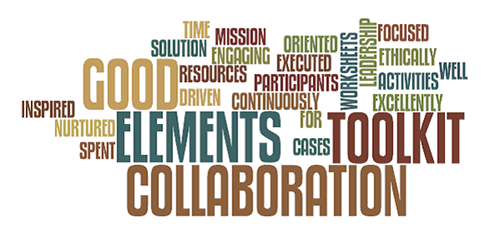May 16 2017 What makes a “good collaboration”? Eight elements for success
 While the Good Collaboration Toolkit was created to help practitioners in a broad range of collaboration types, we’ve found it to be particularly useful for cross-sector work. We first discovered the Toolkit while searching for resources to support the tactics in our own Toolkit for Intersector Collaboration. You can now find it as a supporting resource for our tool Communicate the Interdependency of Each Sector.
While the Good Collaboration Toolkit was created to help practitioners in a broad range of collaboration types, we’ve found it to be particularly useful for cross-sector work. We first discovered the Toolkit while searching for resources to support the tactics in our own Toolkit for Intersector Collaboration. You can now find it as a supporting resource for our tool Communicate the Interdependency of Each Sector.
By Danny Mucinskas, Project Manager, The Good Project
“Collaboration” is a commonly used buzzword in education and employment today. While the concept is as old as human history, collaboration has now become necessary and is often seen as a positive feature of any project or workplace. In fact, the amount of time people spend collaborating with one another has risen in recent years. According to data from the Harvard Business Review, over the past two decades, time spent in collaborative activities by employees across the board has risen on average by fifty percent or more.
This increase in collaboration is due to a few concurrent trends. New technologies (such as email, social media, and explicitly-designed collaboration software) allow us to easily work in close contact. The quickening pace of globalization allows for cross-cultural exchange. And we also increasingly recognize the implicit benefits that collaboration itself has on morale and creativity.
However, collaboration is not always easy, and some partnerships are destined to fail. Think about collaborations you have worked on in your own life. Despite the best of intentions, how many times have you become frustrated by time-consuming teamwork, got the feeling you weren’t being listened to, or watched an endeavor fall apart when two parties couldn’t reach agreement or had differing expectations?
Researchers at the Harvard Graduate School of Education set out to explore why and how collaborations between organizations succeed or fail. From 2009-2015, the “Good Collaboration Project” examined collaboration among non-profit organizations and institutions in education to understand what constitutes “good collaboration.” The project collected qualitative data from interviews with more than 50 individuals who led and participated in these collaborations.
The results of this study led to the creation of the Good Collaboration Toolkit, a set of materials designed to help people develop, nurture, and reflect on effective collaborations.
The Toolkit is structured around eight essential elements that successful collaborations should develop. These elements (which conveniently spell out the word ELEMENTS acrostically) are as follows:
- Excellently Executed (not haphazard or amateurish in process);
- Leadership Driven (not without a vision, but not leader-dominated or unnecessarily hierarchical);
- Engaging for Participants (not without meaning, not narrowly-focused);
- Mission Focused (not all over the map, not with contradictory goals);
- Ethically Oriented (not self-serving, based on power, or exhibiting “compromised work”);
- Nurtured Continuously (not neglected or left to whim);
- Time Well Spent (not time wasted, not reliant on impulse or rigid routine); and
- Solution Inspired (not aimless or without a specific goal or product).
For each of these components, researchers have designed a set of corresponding key questions, narratives, and activities in the Toolkit which are intended to help groups achieve corresponding agreement or participate in individual or group reflection.
Take, for example, the “Mission Focused” element. For this feature, participants are asked to consider questions such as “Can you describe the mission of your collaboration?” and to read two narratives, one which spotlights a collaboration with a well-defined mission and another case in which competing or contradictory missions were an issue. The associated activities include thought exercises and discussion prompts meant to help clarify mission in collaborative partnerships.
Deliberately flexible and non-directive, the Toolkit is intended to be used as needed by a variety of audiences in many sectors. Whether you are a teacher embarking on an inter-departmental project, a business professional working as part of an international team, or a consultant helping to facilitate a collaborative experience for others, the Good Collaboration Toolkit has something for anyone who is a member of a team or partnership.
Click here to find out more about the Good Collaboration Toolkit.
The Good Collaboration Toolkit is a resource of The Good Project, a research endeavor at Project Zero at the Harvard Graduate School of Education. The Good Project’s mission is the promotion of excellence, engagement, and ethics in education and the wider world, preparing people to be good workers and good citizens who contribute to the overall well-being of society.
